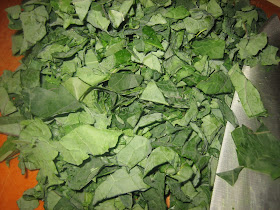Swiss chard (also called just chard) is a often declared a "vegetable valedictorian"! It is a rich source of beta-carotene, fiber, potassium, manganese, and magnesium. It also supplies vitamins C, E, and high levels of K. But it is also contains oxalates, which can lead to kidney stones if you are prone to them. Thankfully, that is one health issue I don't have, so I get to eat Swiss chard daily if I want to, and I often do! We have abandoned planting any spinach in the past few years, in favor of planting more chard instead. The spinach always seemed to bolt too early and didn't yield very much. Chard, in contrast, just keeps pumping away all summer and into the fall in our garden. And the colorful stalks make it much more attractive than spinach. I often substitute chard for spinach in most recipes in the summer when it is so abundant in our garden.
 |
| Our garden chard |
It made me curious about the differences between the two vegetables. My quick search showed that chard is a member of the same family as spinach and beets. No wonder I could easily swap out the spinach for chard. And did chard come from Switzerland? No, the plant did not originate in Switzerland as the name implies. It originated in Sicily and it is a staple of Mediterranean cuisine. But a Swiss botanist determined the scientific name for the plant and his homeland has been honored since the 19th century for his contribution.
Both chard stems and leaves are tasty, but it is the leaves that are the powerhouse of nutrition while the stems don't contain nearly as much. There are several varieties of chard, based on the color of the stem, including green, white, yellow, and red stems. The white stems tend to be the most tender, but I love the color of the red stems. Tom plants "Rainbow chard" which is a collection of all of the colors. No matter what color you use, this recipe is dynamite!
Ingredients:
2 teaspoons coconut oil
1/4 cup chopped green pepper
1 bunch Swiss chard, stems and leaves,chopped (Separate the chopped stems from the chopped leaves)
(about 2 cups total chopped)
About 1 Tablespoon chopped fresh tarragon, or more if desired
1/8 teaspoon Nature's Seasons
6 egg whites
Preparation:
Heat oil over medium heat. Add chopped green pepper and chopped stems from the chard. Saute until tender, adding a bit of water if needed. Add the chopped chard leaves and fresh tarragon. Saute until tender, again adding a bit of water if needed. Let cool slightly. Pour into Magic Bullet (or similar device), add the uncooked egg whites and Nature's Seasons. Process until desired consistency is achieved. Pour contents into a fry pan lightly coated with coconut oil, and cook on medium heat until egg whites are fully cooked. If there is too much liquid from adding too much water to the vegetables, simply drain it off and cook all of it a bit longer. Divide into two portions and share with a friend or save it for yourself for another day! Or your partner could use half of the sauteed vegetables and half of the egg whites to put into an omelet or frittata if they don't need pureed food. Either way, a garnish of fresh tarragon adds visual Pzazz!
Nutrition per serving:
Servings per recipe: 2
Serving Size:
Calories: 97
Total Fat: 5 g
Cholesterol: 0 mg
Sodium: 326 mg
Total Carbs: 2 g
Dietary Fiber: 1 g
Protein: 12 g
Both chard stems and leaves are tasty, but it is the leaves that are the powerhouse of nutrition while the stems don't contain nearly as much. There are several varieties of chard, based on the color of the stem, including green, white, yellow, and red stems. The white stems tend to be the most tender, but I love the color of the red stems. Tom plants "Rainbow chard" which is a collection of all of the colors. No matter what color you use, this recipe is dynamite!
 |
| Garden pepper |
 |
| Sauteed chard, peppers, and tarragon |
Ingredients:
2 teaspoons coconut oil
1/4 cup chopped green pepper
1 bunch Swiss chard, stems and leaves,chopped (Separate the chopped stems from the chopped leaves)
(about 2 cups total chopped)
About 1 Tablespoon chopped fresh tarragon, or more if desired
1/8 teaspoon Nature's Seasons
6 egg whites
Preparation:
Heat oil over medium heat. Add chopped green pepper and chopped stems from the chard. Saute until tender, adding a bit of water if needed. Add the chopped chard leaves and fresh tarragon. Saute until tender, again adding a bit of water if needed. Let cool slightly. Pour into Magic Bullet (or similar device), add the uncooked egg whites and Nature's Seasons. Process until desired consistency is achieved. Pour contents into a fry pan lightly coated with coconut oil, and cook on medium heat until egg whites are fully cooked. If there is too much liquid from adding too much water to the vegetables, simply drain it off and cook all of it a bit longer. Divide into two portions and share with a friend or save it for yourself for another day! Or your partner could use half of the sauteed vegetables and half of the egg whites to put into an omelet or frittata if they don't need pureed food. Either way, a garnish of fresh tarragon adds visual Pzazz!
Nutrition per serving:
Servings per recipe: 2
 |
| Served with whole wheat bread spread with coconut oil |
Calories: 97
Total Fat: 5 g
Cholesterol: 0 mg
Sodium: 326 mg
Total Carbs: 2 g
Dietary Fiber: 1 g
Protein: 12 g










